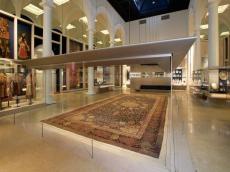|
|
TODAY.AZ / Arts & Entertainment
Sheikh Safi carpet: Eighth wonder of the world
25 September 2022 [14:57] - TODAY.AZ

By Azernews
By Vugar Khalilov
Azerbaijan is one of the oldest centers of carpet weaving in the world. The art of carpet weaving, which is the national-cultural asset of the country, and has become a symbol of the Azerbaijani people, is distinctive owing to its high creativity and technical proficiency, including its unique ornaments.
With its antiquity, unique design, and superior craftsmanship, the renowned Sheikh Safi carpet is, undoubtedly, one of the best examples of global carpet art. The legendary carpet - a unique piece of art that the Azerbaijani people gifted to the world's cultural heritage - was woven in 1539.
According to historians, the idea of creating the carpet belonged to Tahmasib I, the son of Shah Ismail Khatai, who founded the Safavid dynasty, to honor his grandfather Abu Ishaq Ardabili. Experts claim that carpet weaving occurred in the same area and time period as the construction of mosques and tomb complexes. The calligraphy and miniatures on the mausoleum's dome and the patterns on the medallion in the center of the carpet are identical.
It has already been established that the carpet was woven by Tabriz craftsman, Maqsud Kasheni, who spent two years before finishing it in 1539. The carpet stands out for its vibrant coloring, a wide range of tones, and exceptional fineness. The master craftsman, who embroidered Iranian poet Hafiz's verses, also mentioned his name on the carpet: "The work by the slave of the holy land, Maqsud Kasheni, 946". The master artisan had no idea that the carpet would one day be referred to as "the eighth wonder of the world".
The textile exhibit has a total size of 56.12 square meters and is regarded as an art miracle by specialists. One million loops were used to weave the carpet. This wonderful example of craftsmanship has been exhibited as the Ardabil Carpet at the Victoria and Albert (V&A) Museum in London. The name Sheikh Safi was given to the carpet by Azerbaijani visual artist Latif Karimov.
Due to a lack of care for cultural heritage, the carpet that had long graced the Sheikh Safi compound was sold at auction in London in 1893. The Victoria and Albert Museum was able to purchase it for 25,000 pounds thanks to a donation from the British people.
The refusal of rich locals to set aside finances for the restoration of the Sheikh Safi complex, which was devastated by the earthquake in Ardabil, was the cause of this apathy. As a result of the locals' disregard for the religious-architectural structure, which was the symbol of the city, the complex's staff was compelled to hold an auction in order to raise money for repairs.
At that time, English carpet trader Ziegler and Co. branches from Manchester were expanding their business in Tabriz. There was a rumor that a company employee had been curious about the carpet's price. After visiting Ardabil in 1843, traveler U. R. Holmes wrote in Tales from the Caspian Coast: "I have never seen a carpet like the one on the floor in the Safavid mosque-tomb." However, in 1891, the carpet vanished from the tomb.
Among the things sold was a pair of carpets that were put on the mosque's floor. They were initially bought by Ziegler and Co., and later one of them was sold to the museum through an auction in London.
Along with the Sheikh Safi carpet, the gold-plated sword of the Safavid ruler Shah Tahmasib I, as well as Safavid miniatures and pottery are displayed among the most valuable items of the Victoria and Albert Museum. Unfortunately, they were all given credit as Iranian artifacts.
URL: http://www.today.az/news/entertainment/225951.html
 Print version
Print version
Connect with us. Get latest news and updates.
See Also
- 24 April 2025 [13:14]
Lecture on Mirza Kadim Irevani's legacy delivered in Kyrgyzstan - 24 April 2025 [12:19]
Book by national writer presented in Kyrgyzstan - 23 April 2025 [14:51]
Gala State Reserve marks its 37th anniversary with tree planting campaign - 23 April 2025 [11:43]
State Philharmonic Hall pays tribute to eminent composer - 22 April 2025 [14:15]
Int'l Jazz Day in Baku to celebrate freedom and inspiration - 22 April 2025 [13:11]
Baku, Tashkent to hold joint art projects - 22 April 2025 [11:05]
Leyla Aliyeva meets with spouse of Secretary General of Central Committee of Vietnam's Communist Party - 22 April 2025 [10:41]
Culture Minister meets with Kyrgyz counterpart in Bishkek - 21 April 2025 [15:38]
Festival in Masalli embraces arts and fosters creative expression - 21 April 2025 [14:33]
Film about Garabagh War premiered in Nizami Cinema Center
Most Popular
 Culture Minister meets with Kyrgyz counterpart in Bishkek
Culture Minister meets with Kyrgyz counterpart in Bishkek
 Trump sees hope for Ukraine-Russia deal, analysts remain skeptical
Trump sees hope for Ukraine-Russia deal, analysts remain skeptical
 Azerbaijan's Chamber of Accounts urges strengthening audits on renewables & green budgeting
Azerbaijan's Chamber of Accounts urges strengthening audits on renewables & green budgeting
 Azerbaijan and China sign mutual visa exemption agreement for ordinary passport holders
Azerbaijan and China sign mutual visa exemption agreement for ordinary passport holders
 Oil exports from Azerbaijan to Tabriz may be on agenda during Pezeshkian's visit to Baku
Oil exports from Azerbaijan to Tabriz may be on agenda during Pezeshkian's visit to Baku
 Israeli media spotlights Azerbaijan’s rising regional clout as strategic Eurasian mediator
Israeli media spotlights Azerbaijan’s rising regional clout as strategic Eurasian mediator
 Leyla Aliyeva meets with Vice-President of Vietnam to expand humanitarian and cultural ties
Leyla Aliyeva meets with Vice-President of Vietnam to expand humanitarian and cultural ties
